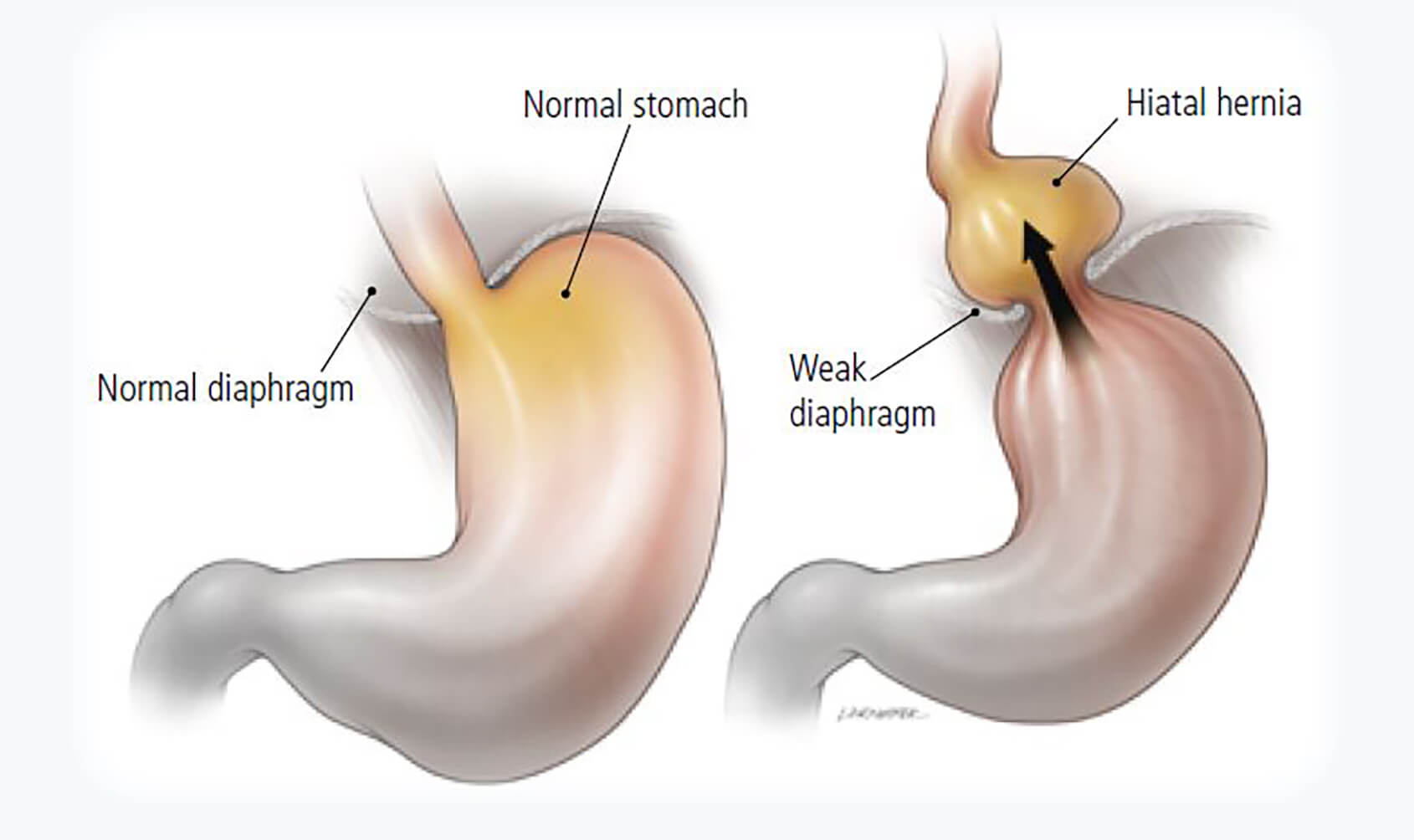Hiatal hernia repair Perth
Hiatal hernia repair

Hiatus Hernia
A hernia occurs when part of your body or an internal organ protrudes through an opening into an area where it shouldn’t be.
Hiatal hernias are most common in either people over 50 and/or those who are obese. One of the main hiatal hernia causes is prevalent in both of these groups. For these individuals, a diaphragmatic hiatus can enlarge or become very floppy. This allows for freer movement of the organs within the cavity.
The diaphragm can also lose its ability to form a firmly fitted structure around the oesophagus, and this may facilitate reflux.
What is a hiatal hernia?
Under normal conditions, the oesophagus carries food from the mouth to the stomach without any problems. It traverses from the chest cavity (thorax) through the opening in the diaphragm (diaphragmatic hiatus), and into the abdomen. You can see this in the diagram below.
A hiatus or hiatal hernia
A hiatal hernia, by contrast, is a condition in which part of the stomach and/or the gastroesophageal junction pushes up through the diaphragm muscle, through a hiatus (a small opening), and into the chest cavity. So the stomach has herniated through the hiatus into the chest. The presence of the hernia can cause pain and heartburn, which are some of the key hiatal hernia symptoms.
In a hiatus hernia, a part of the stomach pushes up through a hole and ends up in the lower part of the chest.

What are the signs or symptoms of a hiatal hernia?
Most small hernias cause no identifiable signs. However, some larger hernias can cause the following symptoms, which help us to make the hiatal hernia diagnosis:
- Painful acid reflux or heartburn
- A feeling of food getting stuck
- Chest or abdominal pain
- Difficulty swallowing
- Shortness of breath
- Vomiting of blood, black stools, or even anemia indicative of gastrointestinal bleeding
How is a hiatal hernia repaired?
The best hiatal hernia treatment is surgery to repair the break in the diaphragm. Hiatal hernia surgery is also very effective to prevent future recurrences.
Your surgeon will pull the stomach back down into your abdomen and secure it with a suture to stop it from slipping up again. Then, they will tighten the hiatus in the diaphragm to achieve some control of your reflux problem.
This will also be reinforced with Bio A mesh to encourage your body’s collagen to strengthen the repair and prevent the hernia from recurring. We like to tighten this hole as much as possible. This maximises the control of the acid reflux, which causes pain and discomfort when the hernia is present.
About Obesity Surgery WA: Our 6 commitments
Taking surgery seriously
We know that entering into an operation is a big deal and we are very serious in getting the best outcome for you. We practice what is considered to be a world class standard. Our staff regularly attend national and international conferences and bring back what is the latest research and technology.Running on time
Our Surgeons and all of our staff try their best to run on time. Although it's not always possible, our commitment is that we do our best. Your time is valuable and we respect that.Readily available
Our surgeons (or at least one of them) are always available in a crisis. Some of them may provide you with a direct contact, but all are available through the hospital switchboard and happy to chat any time if there is a crisis.An obsessive attention to detail
We do our best to not miss anything. Every stitch, every staple and every clip is applied to exactly where it needs to be with the greatest care possible.Commitment to performing the best operation possible
Not all operations are the same and there a few extras that we do to make things better. We know that our results are better with the minimiser ring so we offer it to everyone. We know that reflux can be an issue so we try to tighten every oesophageal hiatus to make reflux control as good as possibly can be.A commitment to new technologies
- We have brought in STRETTA into Western Australia, which we believe will revolutionise reflux management. (Have a look at the Stretta page for more information).
- SJOG Murdoch has just purchased a new DaVinci robot and we believe that this will allow us to do operations with keyhole surgery that previously needed a major laparotomy incision. Lynx is on the horizon and promises to also help manage reflux, we hope to have access to this in early 2020.
Meet our team

Dr. Harsha Chandraratna
Consultant Surgeon
MBBS FRACS

Dr. Bill Gong
General and Laparoscopic Surgeon
MBBS FRACS
